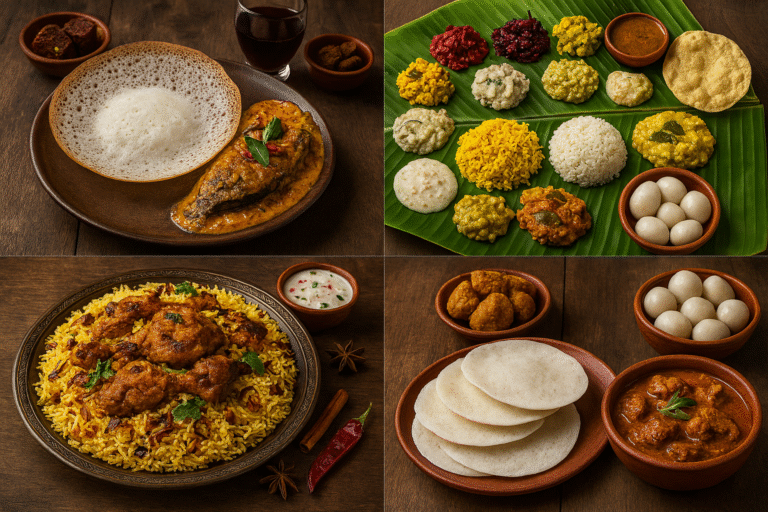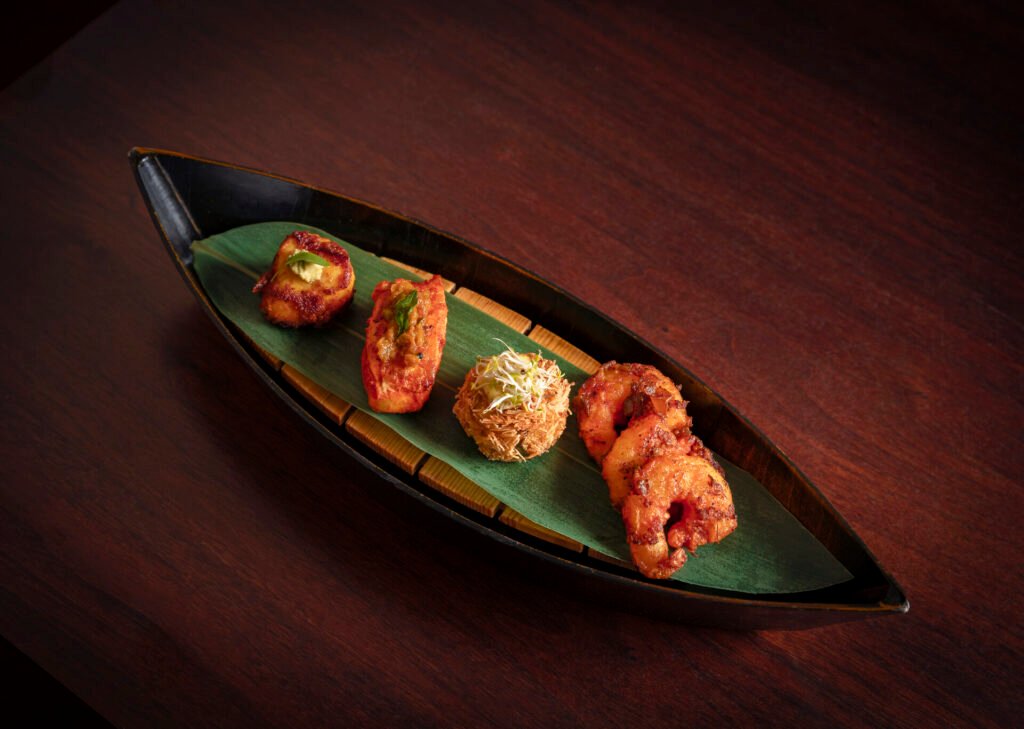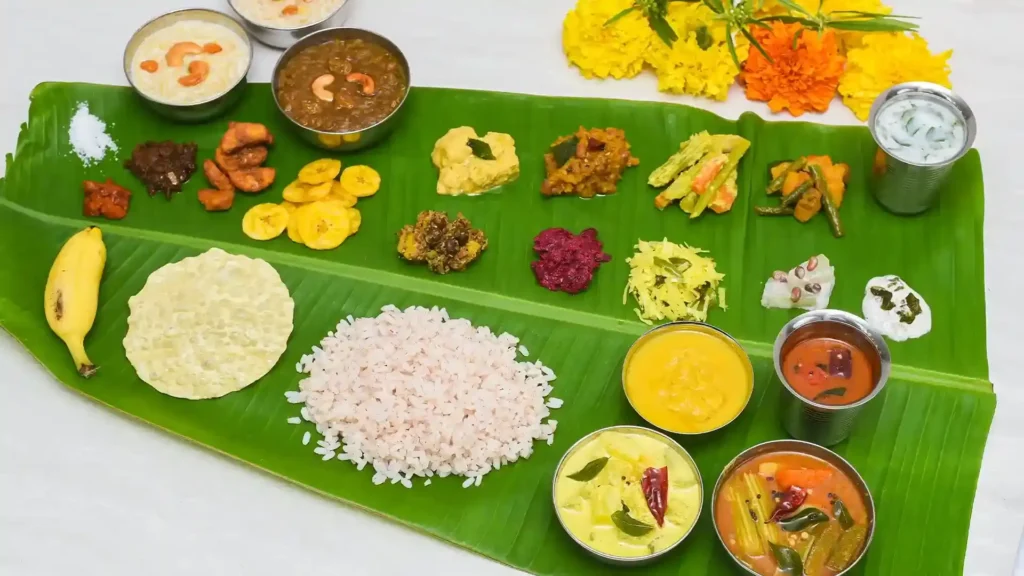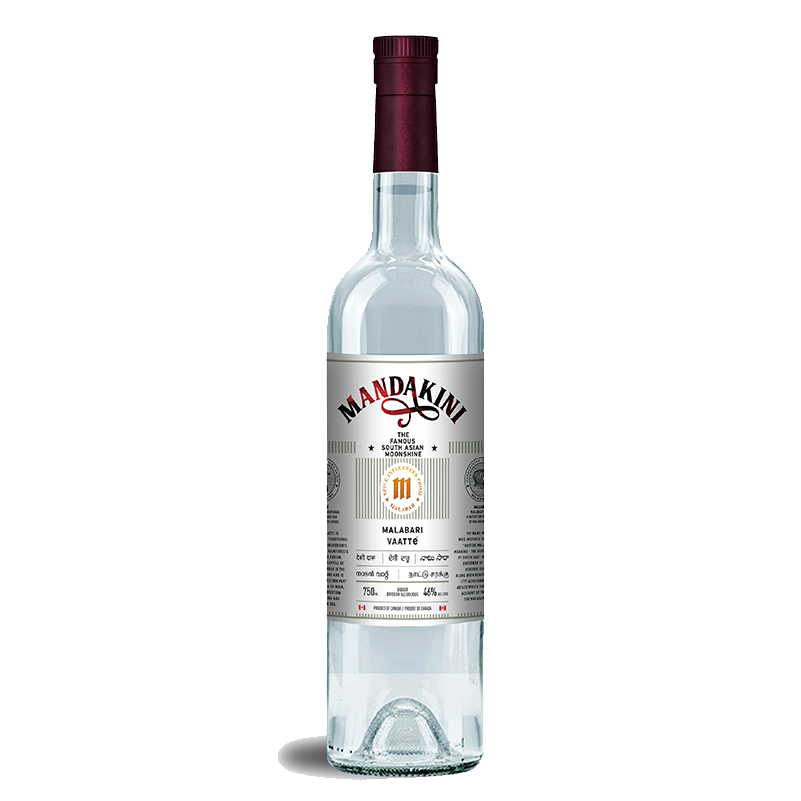
Traditional cuisines of Christian, Hindu, and Muslim communities in Kottayam District, Kerala
Traditional cuisines of Christian, Hindu, and Muslim communities in Kottayam reflect rich culinary diversity—featuring appam, sadhya, biryani, and more.
Explore key dishes, ingredients, and cultural food habits.
Christian Cuisine (Syrian Christian Influence)
- Appam with meat or fish curry
Soft, lacy appams paired with Karimeen Mappas or beef stew.
Coconut milk and spices dominate the flavor. - Pidi and chicken curry
Rice dumplings in coconut milk served with roasted coconut chicken curry. Unique to Kottayam homes. - Pork and beef dishes
Often cooked with fried coconut shards and pepper. Popular during festive gatherings. - Homemade wine and cakes
Christmas season brings grape wine and plum cake. Many families bake at home or buy from local bakeries. - Tea-time snacks
Avalos podi, ariyunda, churuttu, and vettu cake. Do you serve snacks with tea at home?
Hindu Cuisine
- Sadhya
A feast with 12–20 vegetarian dishes served on banana leaves.
Includes avial, thoran, olan, and payasam. - Puttu and kadala curry
Steamed rice cake with black chickpea curry.
Common breakfast across households. - Kappa and meen curry
Tapioca with spicy fish curry.
Often eaten for lunch or dinner. - Temple offerings
Unniyappam, neyyappam, and prasadam payasam.
Have you tasted temple-style payasam?
Muslim Cuisine
- Pathiri with chicken curry
Thin rice pancakes served with spicy meat curry.
Common during Ramadan and celebrations. - Biryanis and meat dishes
Mutton, beef, and chicken biryanis with Malabar spices. Often cooked for Friday meals and weddings.
- Snacks and sweets
Kozhukatta, mutta mala, and chattipathiri.
Do you prefer sweet or savory evening snacks? - Use of ghee and dry fruits
Enhances richness in festive dishes.
Adds depth to flavor and texture.
Which of these dishes do you cook or enjoy most often?

Traditional Cuisines of Malabar: Christian, Hindu and Muslim Food Practices
Muslim Cuisine (Mappila Community)
• Malabar biryani
Made with kaima rice, ghee, fried onions, and whole spices. Chicken, mutton, or prawn are common choices. Thalassery is known for its biryani culture.
• Pathiri and meat curry
Thin rice pancakes served with spicy beef or chicken. Often eaten during Ramadan and Eid.
• Chattipathiri and mutta mala
Layered pastry and egg-thread dessert. Served at weddings and festive gatherings.
• Arab influences
Use of dry fruits, cinnamon, cloves, and cardamom. Do you notice Persian or Turkish touches in your family recipes?
• Cooking in manchatti (clay pots). Adds smoky flavor and aroma.
Christian Cuisine
• Meat roasts and cutlets
Beef, pork, or chicken with vinegar and fried coconut.
Common during Christmas and weddings.
• Appam with stew
Fermented rice pancakes with coconut milk-based curry.
Duck or chicken are popular choices.
• Pidi and kozhi curry
Rice dumplings with spicy chicken gravy.
Do you serve this during church feasts?
• Western touches
Cakes, soups, and baked dishes reflect colonial influence.
Portuguese and British flavors blend with Kerala spices
Hindu Cuisine
• Kootu curry, olan, and avial
Mixed vegetable dishes with coconut and mild spices.
Served during temple festivals and Onam.
• Payasam varieties
Rice, lentil, or vermicelli-based sweet dishes.
Made with jaggery and coconut milk.
• Kalan and pachadi
Yogurt-based sides with banana or cucumber.
Do you prepare these for sadhya or daily meals?
• Rice as staple
Red rice with seasonal vegetables and pickles.
Often served on banana leaves. Each reflects trade history, migration, and local ingredients. Which of these dishes do you cook or crave?
Experience authentic South-West coastal Indian cuisine at Quilon London. Chef Sriram Aylur serves traditional Kerala and Goan dishes with modern techniques at Taj 51 Buckingham Gate. Quilon brings the authentic flavors of South-West coastal India to London’s heart. Located within Taj 51 Buckingham Gate, this restaurant presents traditional cuisine with contemporary flair. The menu celebrates the region’s culinary heritage through fresh spices and seasonal ingredients. Each dish balances rich flavors with refined presentation.
Signature Dishes You Must Try
Seafood Specialties:
- Lobster Pepper-Garlic – A coastal classic with aromatic spices
- Seafood Moilee – Traditional coconut curry with fresh catch
- Baked Black Cod – Modern technique meets traditional flavors
The kitchen uses freshly ground spices daily. This approach creates layers of flavor that define authentic coastal Indian cooking.
Wine and craft beer pairings complement each dish. The curated selection enhances the dining experience without overwhelming the delicate spice profiles.
Chef Sriram Aylur: Master of Coastal Cuisine
Chef Sriram learned cooking in his father’s kitchen on India’s coast. That foundation shaped his approach to South-West Indian cuisine over three decades.
Career Milestones:
- Joined Taj Hotels in 1989. Opened Karavali restaurant in Bangalore (now an iconic Southern Indian destination). Launched Quilon London in 1999. Led Quilon for 25 years with consistent quality. His cooking philosophy centers on heritage recipes adapted for modern palates. The result is cuisine that honors tradition while embracing contemporary techniques.
What Makes Quilon Different
You’ll find authentic coastal flavors prepared with modern precision. The restaurant sources ingredients that match the quality found in India’s coastal regions. The spice blends follow traditional recipes passed down through generations. Fresh grinding happens daily to preserve essential oils and flavors. Seasonal menus reflect the natural rhythm of coastal Indian cooking. This approach keeps dishes fresh and connects diners to authentic regional practices.
Location and Atmosphere
Taj 51 Buckingham Gate provides an elegant setting for this culinary journey. The location puts you in London’s heart while transporting your senses to India’s coast. The restaurant design reflects the coastal regions it represents. Clean lines and natural materials create a contemporary space that honors traditional aesthetics.
Planning Your Visit
Quilon serves lunch and dinner with seasonal menu changes. Reservations help secure tables during peak dining hours. The restaurant accommodates dietary restrictions common in Indian cuisine. Vegetarian and vegan options showcase the same attention to spice blending and technique. Wine service includes selections that pair well with complex spice profiles. The sommelier understands how different wines interact with traditional Indian flavors.
Quilon at Taj 51 Buckingham Gate offers authentic South-West coastal Indian cuisine in London. Chef Sriram Aylur, with over 30 years of experience, creates dishes that honor traditional recipes while using modern techniques. The restaurant features signature items like Lobster Pepper-Garlic and Seafood Moilee, prepared with freshly ground spices and seasonal ingredients. Quilon provides a contemporary dining experience that celebrates the cultural richness of India’s coastal regions through refined presentation and carefully curated wine pairings.
Discover Kerala’s Sadya, a traditional vegetarian feast served on a banana leaf. Learn about its 28 dishes, from rice and curries to side dishes, pickles, and Payasams. Kerala Sadya A Feast of Flavors: Sadya is Kerala’s most iconic vegetarian feast. It can feature up to 28 dishes at a time. You eat it on a plantain leaf, always placed with the narrow end to your left. The sequence of serving makes Sadya unique.
The Core of Sadya
Rice
Par-boiled red rice forms the base of the meal. It is served at the lower side of the banana leaf.Parippu
A simple curry made with lentils and ghee, usually the first dish after rice.Sambar
A South Indian favorite made with mixed vegetables, lentils, onions, tamarind, coriander, and spices.
Popular Side Dishes
Avial
A mix of vegetables, coconut paste, and green chillies. Coconut oil and curry leaves are added at the end.Thoran
Finely chopped vegetables like beans, cabbage, or radish mixed with grated coconut and spices.Olan
Pumpkin and red gram cooked in coconut milk.
Savouries and Pickles
Upperi – Banana chips, deep fried till crisp.
Pappadam – Thin wafers made from black gram flour.
Kichadi – Cucumber or ladyfinger in curd, tempered with mustard and curry leaves.
Pickles – Mango and lime varieties add sharp flavours.
Inji Curry – Sweet and spicy ginger pickle.
The Dessert Tradition
Payasam is the highlight.
Popular types include: Pal Payasam (milk-based); Palada Pradhaman (rice ada and milk); Kadalaparippu Pradhaman (lentils and jaggery)
Each is garnished with cashews and raisins.
A ripe banana, Pazham, is eaten along with Payasam.
Closing the Feast
Rasam – Tamarind juice spiced with pepper and chilli.
Kaalan – Buttermilk seasoned with turmeric and green chillies.
Moru – Spiced buttermilk for digestion.
The meal ends when you fold the banana leaf.
Why You Should Try Sadya
It is a celebration of Kerala cuisine.
Every dish has a purpose—taste, balance, or digestion.
You experience flavours ranging from sweet and sour to spicy and tangy. Have you ever tried a full Kerala Sadya? Would you go for all 28 dishes or keep it simple with your favorites?
Discover Mandakini Original Malabari Vaatte, a handcrafted unaged spirit made from sugarcane extract. Inspired by Kerala’s 400-year toddy tradition and distilled in Canada.
Mandakini Original Malabari Vaatte
Malabari Vaatte is more than a drink. It carries the heritage of Kerala’s sugarcane and toddy-making traditions.
Key Details
Handcrafted unaged spirit from sugarcane extract. ABV: 46%. Volume: 750 ml. Distilled in Vaughan, Ontario, Canada
Local Names
Desi Daroo. Nattu Charakku. Nadan Vaatte. Nattu Sara
Heritage and Inspiration
The Malabari region sits between the Western Ghats and the Arabian Sea. Known as the land of monsoon and the spice capital of the pre-colonial world, it shaped Kerala’s drinking culture.
The practice of fermenting sugarcane extracts and tropical fruits has been part of Kerala for centuries. Mandakini draws inspiration from:
The 400-year-old history of toddy making
The Hortus Malabaricus, a 17th-century botanical work on the plants of the Western Ghats. Malabari refers to people from Kerala’s southwest coast. “Vaatte” is the Malayalam word for unaged spirit.
Tasting Notes
Aroma: Earthy and vegetal with fruity hints
Palate: Semi-sweet with ripened banana and tropical fruit notes
Finish: Long, sweet, with a peppery edge
Why It Stands Out
You get a spirit rooted in Kerala’s heritage, but crafted with care in Canada.
You taste sugarcane, fruit, and spice traditions that span centuries.
You drink a bottle that connects history with your glass.
Mandakini Original Malabari Vaatte is an unaged sugarcane spirit inspired by Kerala’s toddy-making traditions and distilled in Canada. With earthy aromas, tropical fruit flavors, and a sweet peppery finish, it bridges 400 years of heritage with modern craft.



